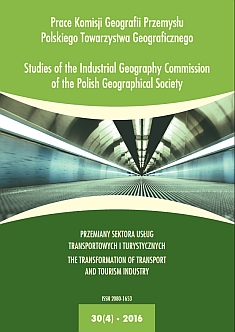Directions of Accomodation’s Changes and its Use on the Croatian Coastline in Years 1993–2013
DOI:
https://doi.org/10.24917/20801653.304.11Keywords:
accommodation, Croatia, tourism, tourist regionsAbstract
The process of disintegration of Yugoslavia which was launched after the death of Josip Broz Tito led to the proclamation of Independence of Croatia on 25th June 1991. The consequence of that decision was civil war which had significance for tourist accommodation’s availability and the level of its use. There has been a strong process of privatization, which extended to cover accommodation facilities since 1995. Government of Franjo Tuđman led almost to the collapse of the Croatian currency by the rise in unemployment and inflation. It has an influence on tourist attractiveness of Croatia from the supply side. Years 2000-2007 were a period with improvement in the situation on tourist services which coincided with the period of economic transition. Unfortunately, lack of serious FDI brought in 2007 and following years for Croatia suppression growth of GDP and the impoverishment of society. Also the international economic crisis has ay impact on the situation on the market of tourist services. In 2007-2008 there was a development of the accommodation facilities and increase the number of tourists while shortening the average duration of their stay. The years 2009-2011 were a period with a decline in the number of tourists in Croatia. It can be explained as a delayed effect of the international economic crisis. However, the slow growth of the accommodation facilities development indicator allows to define the period as a stage of positive changes in the market of tourist services. In 2012 there was a significant decrease in the number of beds at a slight increase in the number of tourists. This has led to more efficient use of accommodation by increasing rates of the accommodation facilities development indicator. In July 2013 Croatia became a member of the EU. This resulted in a direct manner to the market of tourist services. There was a significant increase in the number of tourists, especially from EU countries, and the development of accommodation facilities. Not without significance for the size of tourist traffic was the introduction of a visa requirement from 1st of April 2013 for citizens of countries such as Russia, Ukraine and Turkey. The changes didn’t affect the average length of stay of tourists in Croatia. During the whole period there was a shift of accommodation from the hinterland to the coastal zone where in 1993 were accumulated 89% of beds and in 2014 were 98% of them.
Downloads
Metrics
References
Markowska, J. (2013). Zróżnicowanie ruchu turystycznego w parkach narodowych Chorwacji. Problemy Ekologii Krajobrazu. Rekreacja w krajobrazach o wysokim potencjale, XXXIV, 181–
Michalski, T. (2012). Przemiany w umieralności w Europie Środkowej i Środkowo-Wschodniej w okresie transformacji. Pelplin: Bernardinum.
Parysek, J.J., Wojtasiewicz, L. (1979). Metody analizy regionalnej i metody planowania regionalnego. Warszawa: PWN.
Rettinger, R. (2010). Turystyka jako czynnik aktywizacji gospodarki Chorwacji. Przedsiębiorczość–Edukacja, 6, 459–461.
Runge, J. (2006). Metody badań w geografii społeczno-ekonomicznej – elementy metodologii, wybrane narzędzia badawcze. Katowice: Wydawnictwo Uniwersytetu Śląskiego.
Wiluś, R., Włodarczyk, B. (1996). Współczesne problemy rozwoju turystyki dalmatyńskiego wybrzeża Chorwacji. Turyzm, 6(2), 101–115.
Downloads
Published
How to Cite
Issue
Section
License
Articles are published under the terms of the Creative Commons License (CC BY-ND 4.0; Attribution– NoDerivs).

